Yohei Nishimura Exhibition wild mountain thyme
2020.10.5 [Mon]-10.24 [Sat]
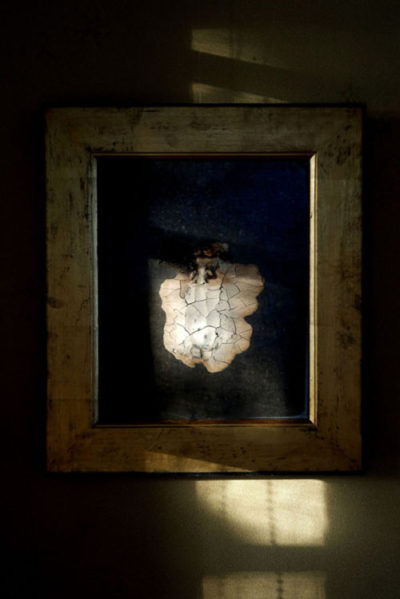
2020.10.5 [Mon]-24 [Sat]
13:00 – 18:30 [日・水 休廊]

Look at the lilies and how they grow.
野の百合は如何にして育つかを思へ、労せず、紡がざるなり。
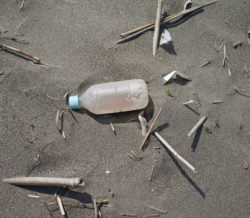
海まで 30分かけて ゆっくり歩く
今日は ペットボトルを 見つけるために
槙の木の根本に 田んぼに 玉ねぎ畑に パイプの下に 海の砂に埋もれて
見ようと思えば 見えるものだ
我が家の草むらに 投げ捨てられたペットボトル
なぜか 「野の花のように」があらわれる
ペットボトルの過去を取り出すための 火葬
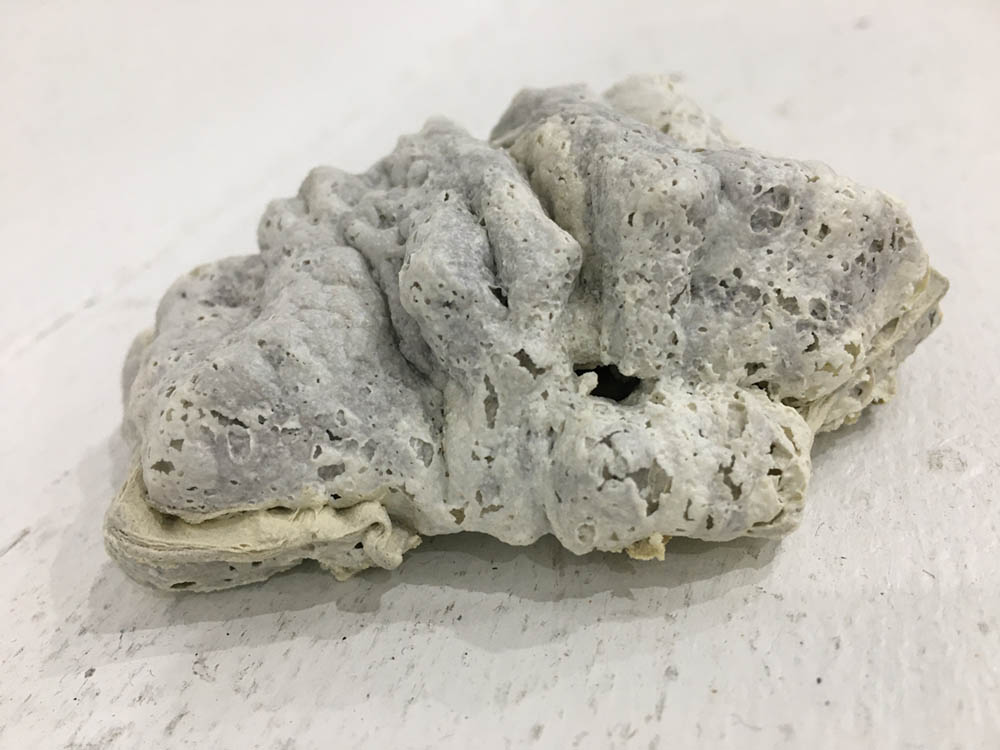
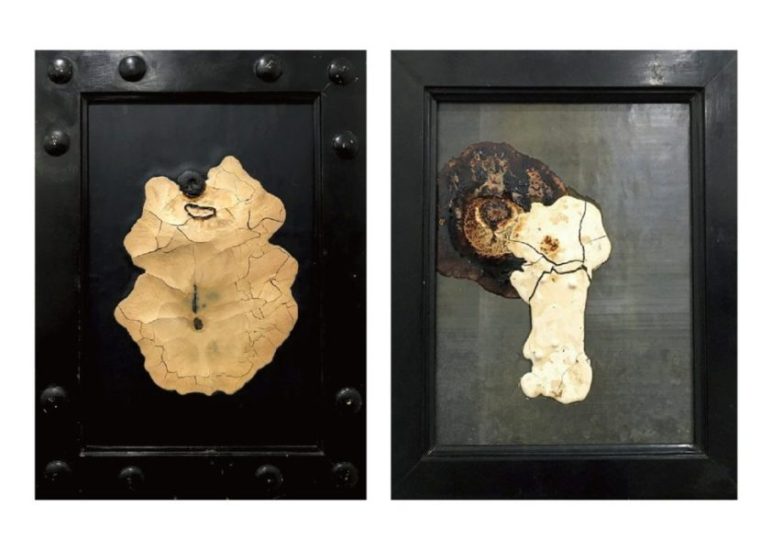
▷西村陽平 art TNZ 直前インタビュー記事 /Art Scenes
“アーティスト・コレクター・ギャラリスト” 3者の目線でアートの魅力を伝える
「”そこに、唯、存在する”ってことが、どんなにかけがえの無いことか」
インタビュー記事はこちら▼
https://art-scenes.net/ja/articles/163/?.ref=fb_post
「焼くことによって自分の痕跡を消すことができるんだよね。
だから、いかにして自分を消して存在することができるか、というような方法論としての方法を使っています。」
-西村陽平インタビューより
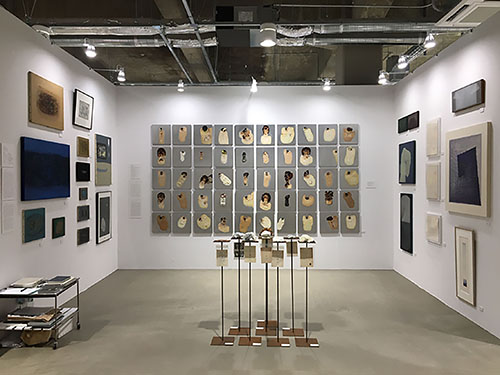
西村陽平と無名性——造化にしたがひて
土田 眞紀(同志社大学講師/美術史)
今回の展覧会に一冊の本が展示される。西村は準備のために築百年以上の古民家に残された本の頁を繰っていて、ある頁に四つ葉のクローバーの押し花が挟まれていることに気づいた。本の中身はアンドレ・ジイドの『未完の告白』、発行年は1938年、押し花の頁のある箇所にはかすかに傍線が引かれていた。その本が作品として出品されている。この話を聞いてふと思い出したのは、「山路来てなにやらゆかし菫草」という芭蕉の句である。芭蕉は山路を歩き、西村は本の頁を繰っていて、それぞれ菫草とクローバーに出会った。二つの出来事は出来事のままに、片や俳句となり片や今回の展示に繋がった。時空を遠く隔てた二つの出来事の間に通じるものがあるように思われた。
芭蕉は「造化にしたがひ、造化にかへれとなり」(『笈の小文』)とし、旅を住処として自然と人為(作為)の区別のない境を求めたとされる。一方、西村はこれまで制作にあたって、人が自らつくった有用のもの、人工、人為の側にあるもの、しかしすでに人々が関心を失って無用となったものを繰り返し取り上げてきた。今回の展覧会も、ジイドの本以外は同じ家に残された道具類を用いて作品を制作している。用途不明の錆びた鉄の道具や水筒をごく一部を残して土と新聞紙等で覆い窯で焼成した作品は、数百年後、数千年後にたまたま土中から発掘された姿にも見える。焼成後間もない写真を見たときには、熱がまだ残っているのか血の通った生き物のような生々しさも感じられた。

焼成によってものは変貌を遂げる。窯のなかで小麦粉はパンになり、 粘土はやきものになり、木片は炭になる。そうして数々の有用のものを人はつくり出してきたが、ひとつ間違えばすべては焼け焦げ、灰になり、無惨な姿を晒すことにもなる。
プロメテウスの神話によれば火を扱うわざは人が持つべきものでなかった。あらゆる技術を手にした今もなお人には制御不可能な領域が火には存在する。
西村は長らく王冠、本、バケツ、工具、林檎、石など、身近にある様々なものを焼成し、有用性と破壊との狭間で思いもかけない変貌を遂げた姿形のままに作品化してきた。焼成は西村自身の意志に基づいて行われるものではあっても、その手の届かない千度を越す窯のなかで、ものが自ずと変化するままに任せることを西村はよしとする。飽くことなく焼成を重ねるその姿勢には、本来造化の主である神のみがもつべきわざにしたがって人為と人為でないものの境が曖昧となり、ものが造化にかえっていく様を見届けようとする強靭な意志すら感じ取れるように思う。造化にしたがう限りにおいて、焼成後の王冠の真っ黒に膨らんだ姿も、文字を失った文庫本の浄化されたかのように白く縮んだ姿も、その間に優劣はないそれぞれの無二の姿である。それらは人のためではない、もの自らが望んだ個の姿にも思える。一切を灰に帰す破壊と背中合わせにものを人為から解き放つ焼成は、長らく人の傍らにあって人のために用立てられてきた道具への手向けともいえるのではないか。土と紙で繭のように道具を包み焼成した今回の作品群にはとりわけそのことを感じた。
道具類とは異なり、本には西村は何も手を加えていない。ただ偶然にその本の頁を繰り、クローバーを見つけ、そして今回の展示に作品として加えた。発行から八十年の間の様々な人為を記憶したその本を、芭蕉にとっての菫草と同じ一つのいのちとして受け止めたとき、西村はやはり造化にしたがっていたのではないだろうか。その点で焼成された西村の作品と本に違いはない。
造形作家としての西村には、淡々と焼成の実験を遂行するかのような手法を通してものの変貌の様を冷静に見つめ、同時に自らの視覚と触覚のあり様への自覚と自省をたゆまず深めていく理智の力がすぐれてはたらいているが、もう一方で彼の制作を支えてきたのは芭蕉に相通じる詩の心であるように思われる。クローバーを見つけたとき、いつもは目と手と理智の奥に控えている詩の心が真っ先に動き、人為と造化の境が紛れたとすれば、若い頃から「美術における無名性」について考えていた西村にとってこの出会いは僥倖といえるものではなかっただろうか。
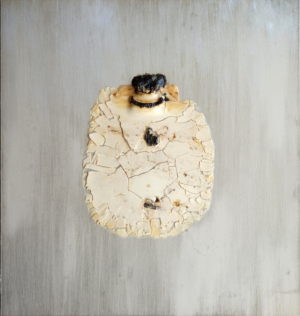
Nishimura Yohei and Anonymity: Conforming to the Wonder of Nature
Tsuchida Maki(Lecturer at Doshisha University / Art Historian)
There is a book that will be displayed in this exhibition. While preparing for the exhibition, Nishimura turned the pages of a book left in an old house built more than a hundred years ago and noticed a pressed four-leaf clover placed between the pages. The book was Mikan no kokuhaku [Genevieve, or The Unfinished Confidence] (1938) by André Gide. There was a faint trace of underlining on the page where the clover had been inserted. This book is displayed as one of the works in this exhibition. Hearing this, I happened to recall a haiku by Matsuo Basho. “Yamaji kite / naniyara yukashi / sumireso [Along a mountain path, somehow so graceful, a wild violet.]” In Basho’s case, while walking along a mountain trail and, in Nishimura’s case, while turning the pages of a book, they came across a violet and a clover respectively. The two incidents led just as they were, one to a haiku and the other to the current display. I feel that though far apart in space time, these two incidents have something in common.

Basho made it a rule to “conform to zoka [the wonder of nature] and return to it.” (Oi no kobumi [Backpack Notes].) He is said to have lived on journey and to have sought a state where there was no distinction between nature and human effort (artificiality). Meanwhile, in producing his works so far, Nishimura has repeatedly employed commodities produced by humans themselves, things on the artificial side, yet those that people have already lost interest in and that have become useless. In the current exhibition, too, with the exception of Gide’s book, all the works were produced employing utensils left in the same house. The works made by covering rusty iron utensils, the uses of which remain unknown, and a canteen with clay, newspaper, etc. leaving just a little bit uncovered and firing them look like pieces which happened to be dug out of the soil several hundred or thousand years later. When I saw photographs of them taken soon after they were fired, whether because they still contained heat, I felt a vividness as if they were living creatures.
Things are transformed by being fired. Flour becomes bread in the oven, clay becomes ceramic, and wood becomes charcoal. Thus mankind has created numerous useful things. Yet, a single mistake can result in everything being burnt, reduced to ashes, and having to expose a miserable sight. According to the myth of Prometheus, mankind should not have obtained the act of handling fire. Even now that human beings have acquired all kinds of techniques, there are still uncontrollable domains of fire. Nishimura has, for many years, been firing a variety of everyday commodities such as bottle caps, books, buckets, tools, apples, or stones. The outward appearance of the unexpected metamorphosis achieved in the threshold between utility and demolition is presented as is as a work. While the firing is undertaken in accordance with Nishimura’s intention, in the unreachable kiln heated to over 1,000°C, he leaves it to the objects themselves to transform of their own accord. The attitude with which he tirelessly continues firing seems to demonstrate his unyielding will to ascertain how the border between artificial and non-artificial, which was originally a working that only God the Creator should have been in command of, becomes ambiguous and how the object returns to the wonder of nature. Insofar as conforming to the wonder of nature, there is nothing to choose between the puffed up, black look of the bottle cap and the shrunken white look of the paperback book seemingly purified having lost its letters. They are each incomparable. They could also be described an individual look sought after by the object itself, not for a person but for its own sake. Back to back with demolition, through which everything is reduced to ashes, firing sets things free from artificiality. Perhaps this could be considered a tribute to the utensils that have long been at the humans’ side and served humans. The group of works presented in this exhibition, which were produced by covering the utensils with clay and paper like cocoons and firing them, made me feel so particularly strongly.
Unlike the utensils, Nishimura has not done anything to the book. He simply happened to be turning the pages of this book, came across the clover, and added it to the current display as a work. This book has memories of the diverse human efforts exerted during the eighty years since its publication. By responding to it as a single life, in the same way as Basho did with the violet, Nishimura may also have been conforming to the wonder of nature. In that respect, there is no difference between Nishimura’s fired works and the book. As a creator of plastic arts, through his method of seemingly undertaking experiments in firing in a serene state of mind, Nishimura calmly observes how things metamorphose and, at the same time, exercises his superb intellect to unceasingly deepen his self-awareness and introspection towards the state of his own visual and tactile sensations. On the other hand, I feel it is also his poetic mentality, which is in some ways akin to Basho, that has supported his creativity. When he came across that clover, the poetic temperament, which normally retreats to the back of the artist’s eyes, hands, and intellect, may have been the first to make a move so that the boundary between artificiality and the wonder of nature became indistinguishable. If so, wasn’t this encounter an unexpected stroke of good luck for Nishimura, who had been pondering over “anonymity in art” from when he was young?
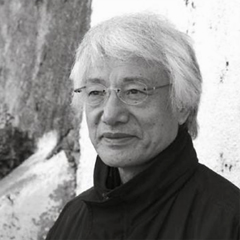
1947年 京都市生まれ。1973年 東京教育大学教育学部芸術学科卒業。1975年頃より、やかんや缶などの金属の焼成に取り組み、日常の世界では見えにくい素材の違いを焼成のプロセスを通じて際立たせる作品を制作し始めた。その後さらに、書籍を1200℃で焼成させた作品のシリーズに取り組む。千葉県立盲学校教諭を23年間つとめ、国内外で触覚をテーマにしたワークショップも多数行っている。
日本女子大学名誉教授
1977「第4回日本陶芸展」外務大臣賞受賞、2019 西村陽平展「花の骨」/画廊香月[銀座]、2020「我ら人生のただ中にあって」画廊香月、artTNZ /東京、画廊香月より出展
パリ装飾美術館/フランス、ビクトリア&アルバート美術館/イギリス、アリアナ美術館/ジュネーブ、東京都現代美術館など、国内外の美術館に作品を多数収蔵。
Born in 1953 in Kyoto, Japan
Graduated from the Tokyo University of Education.
Since about 1975, he has been working on the firing of metals such as kettles and cans, and has begun to create works that emphasize the differences in materials that are difficult to see in the everyday world through the firing process. After that, he worked on a series of works in which books were fired at 1200℃.A pioneer in specialized teaching for the blind in Japan, he taught for 23 years at a school for the visually impaired in Chiba .
Professor of Japan’s Women’s University in Tokyo (~2016)
Awarded The Foreign Minister’s prize by the Japan ceramic art exhibition 1977.
Yohei Nishimura Exhibition “Bone of Flower” / Gallery Kazuki,Ginza
His works can be found in numerous collections including those of the Museum of Contemporary Art of Tokyo, the Museum of Decorative Arts in Paris, the Ariana Museum in Geneva and the Victoria and Albert Museum in London.
アーティスト詳細 ▼